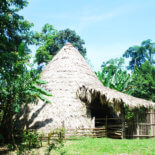Envisioning Vengeance
Rebellious Indigeneity, Gender and Genre in Jayro Bustamante’s La Llorona
Throughout the western hemisphere in recent years, there has been a notable increase in fictional texts (novels, television, movies) by Black, Indigenous, and artists of color—many of whom identify as queer and/or women—that fall within the category of the “speculative,” i.e. fantasy, science fiction, and horror. Some examples include the novels La Mucama de Oricunlé by the Dominican writer Rita Indiana, and Los Hijos de la Diosa Huracán by the Cuban-American writer Daina Chaviano; the Brazilian film As Boas Maneiras, directed by Marco Dutra and Juliana Rojas; the U.S. Black Panther films, directed by Ryan Coogler; the Mexican film Selva Trágica, directed by Yulene Olaizola; and many others. [1] All these examples either directly or indirectly address the legacies of colonialism and slavery, drawing upon genre conventions like time travel, magic, and reanimation, and exploring the possibilities of posthuman bodies like cyborgs, human-animal hybrids, and the undead for expressing these historical phenomena and their resonances in the present. Given its broad impact and cultural importance, film as a medium is unique in its ability to critique essentialist notions of race, gender, sexuality, and social identity through these posthuman representations. Classic horror is a cinematic genre particularly concerned with soliciting strong affective responses from its audience through depictions of monstrous non- and post-humans, making it well equipped to transmit emotional charges based on historical traumas. While these traumas have often been ignored by official narratives, such as those expressed in written documentation and political speech, horror cinemas can provide audiences access to them in ways that circumvent dominant representations. In sociohistorical conditions that seek to negate the histories of certain groups, audiovisual productions can thus function as indispensable tools for recuperating stories that have been silenced. Here I will examine the Guatemalan film La Llorona [2] and its contributions to the horror genre, focusing on how its depiction of monstrosity reworks a global genre into a local context in order to connect more effectively with Guatemalan audiences while also achieving a wider viewership. La Llorona, written and directed by Jayro Bustamante, was strategically marketed as a horror film in order to get audiences to the theater, and it was later released through the online horror media platform Shudder. It reinterprets the myth of La Llorona (well known throughout Central and South America as the vengeful, weeping woman crying for the death of her children) as the motherland of Guatemala crying for…



